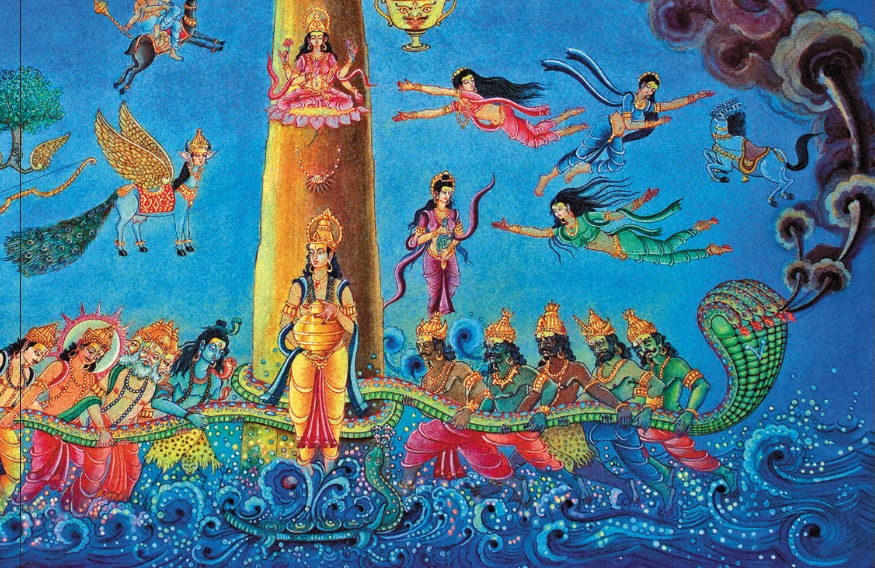Deep in india’s ancient past, knowledge was often conveyed in allegory. One such meaningful chronicle of yore provides a dramatic explanation for the auspiciousness of the world-famous Kumbha Mela. Although variations of this tale abound, one popular version goes like this:
A long time ago, just after the creation of the universe, the Gods of heaven and the demons of the lower worlds were experiencing a most uncomfortable debilitation of their most fundamental life force. After due deliberation, they determined that their perplexing dilemma was due to the fact that a divine substance called amrita had not been properly flowing forth from the source of all things. This emergency inspired a miracle of sorts. The Gods and demons decided to bind their forces and work together to regenerate this much-needed, live-giving elixir.
It had been speculated that churning a certain famous ocean of milk in heaven could manifest this divine substance. Wasting no time, the Gods and demons found this ocean and enlisted the assistance of a sea serpent named Vasuki to act as a churning rope. The Gods pulled her tail, the demons pulled her head and the resulting agitation galvanized quite an unexpected perturbation. Unfortunately, poison got created before amrita. Lord Siva sprang to the rescue and drank the dangerous substance before it could cause harm to heaven, Earth or hell. Although the poison turned Siva’s throat blue, the Gods and demons were able to continue their churning and finally produced their magic elixir. This is not the end of the story. Almost immediately, another tussle began. Although the devas and demons had previously agreed amicably on a 50/50 split of the treasured substance, they each now clamored to seize it all. In the struggle that ensued, the demons ultimately prevailed, causing the Gods great concern.
Lord Vishnu tried to get the elixir back in a less than forthright manner by magically assuming the form of Mohini, a beautiful woman. Under the pretence of splitting the amrita equally for each of the two groups, he disguised liquor as the demon’s portion and gave all of the real elixir to the Gods. Unfortunately, the demons caught on to this ploy and became infuriated. They snatched the amrita back from the Gods, and yet another struggle began.
Finally, Jayant–the son of Indra, King of the Gods–got hold of the elixir and flew off with it. Far and wide he fled. For rest on Earth, he touched down in only four places–all in India. At each of these spots, he drank a little of the sacred substance he was carrying to renew his energy. Each time he drank, a few drops of the precious liquid fell to the ground. These locations, where the amrita touched the Earth, eventually became the four hallowed sites of the Kumbha Mela.
From a more practical point of view, the Kumbha Mela is a gathering of the great monastic orders of India, known as akharas. At the high point of the Mela, hundreds of thousands of these renunciate monks travel in grand procession to a nearby river’s edge for the shahi snan, “royal bath, ” while pilgrims line the streets to watch.
The Kumbha Mela takes place every four years in rotation: at Haridwar, Prayag (Allahabad), Nashik and Ujjain, according to the position of Jupiter in the Zodiac. A modern innovation are the popular half-melas, ardha-kumbhas, every six years at Haridwar and Prayag. It was at Prayag, where the Yamuna River joins the Ganga, that the largest number of human beings in history gathered. On January 24, 2001, 30 million pilgrims came together, doubling its own single-day record of 15 million set on February 6, 1989. Haridwar, which is logistically less convenient, managed ten million on April 14, 1998. Still, that’s five times the second largest gathering on record–two million Muslim pilgrims who converge in Mecca for the Haj each year.
The most prominent akharas are Juna and Niranjani. Others include the Agan, Alakhiya, Abhana, Anand, Mahanirvani and Atal. Most orders are Saivite, three are Vaishnavite (formed beginning in 1299 by Saint Ramananda Ji) and a few are Sikh orders patterned after the Hindu monastic system. Akhara is Hindi for a “wrestling arena.” It can mean either a place of verbal debate or one of real fighting. Each akhara may contain monks of several different Dasanami orders–the ten designations–Saraswati, Puri, Bana, Tirtha, Giri, Parvati, Bharati, Aranya, Ashrama and Sagara, as organized by Adi Shankara around 800 ce. There are also sannyasi orders, such as the Nathas, that exist outside the Dasanami and akhara systems. The akharas’ dates of founding range from the sixth to the fourteenth century, though large monastic orders have existed throughout India’s long history.
Many are the motivations and benefits for Hindus to attend the Kumbha Mela, the most popular pilgrimage on Earth. It is a time to gain a new look on life, to purify oneself and to regain the sense of Godly aspiration as the central purpose for this incarnation on the spinning orb we call Earth.
